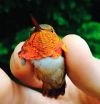(Press-News.org) CORVALLIS, Ore. – A new model analyzing how birds in western North America will respond to climate change suggests that for most species, regional warming is not as likely to influence population trends as will precipitation changes.
Several past studies have found that temperature increases can push some animal species – including birds – into higher latitudes or higher elevations. Few studies, however, have tackled the role that changes in precipitation may cause, according to Matthew Betts, an Oregon State University ecologist and a principal investigator on the study.
"When we think of climate change, we automatically think warmer temperatures," said Betts, an associate professor in Oregon State's College of Forestry. "But our analysis found that for many species, it is precipitation that most affects the long-term survival of many bird species.
"It makes sense when you think about it," Betts added. "Changes in precipitation can affect plant growth, soil moisture, water storage and insect abundance and distributions."
Results of the study, which was funded by the National Science Foundation with support from the U.S. Geological Survey and others, are being published in the journal Global Change Biology.
The researchers examined long-term data on bird distributions and abundance covering five states in the western United States, and in the Canadian province of British Columbia, testing statistical models to predict temporal changes in population of 132 bird species over a 32-year period. They analyzed the impacts of temperature and precipitation on bird distributions at the beginning of the study period (the 1970s) and then tested how well the predictions performed against actual population trends over the ensuing 30 years.
The scientists keyed in on several variables, including possible changes during the wettest month in each region, the breeding season of different species, and the driest month by area. Their model found that models including precipitation were most successful at predicting bird population trends.
"For some species, the model can predict about 80 percent of variation," Betts said, "and for some species, it's just a flip of the coin. But the strongest message is that precipitation is an important factor and we should pay more attention to the implications of this moving forward."
The study incorporated a lot of complex variables into the model, including micro-climatic changes that are present in mountainous environments. The research area encompassed California to northern British Columbia and the mountain systems drive much of the changes in both temperature and precipitation.
The researchers chose December precipitation as one variable and found it to be influential in affecting bird populations.
"Someone might ask why December, since half of the bird species usually present in the Pacific Northwest, for instance, might not even be here since they're migratory," Betts noted. "But much of the critical precipitation is snow that falls in the winter and has a carryover effect for months later – and the runoff is what affects stream flows, plant growth and insect abundance well down the road."
The rufous hummingbird is one species that appeared affected by changes in December precipitation, the researchers say. The species is declining across western North America at a rate of about 3 percent a year, and the model suggest it is linked to an overall drying trend in the Northwest. The evening grosbeak is similarly affected the authors say.
On the other hand, the California towhee shows a negative association with December precipitation, appears to be drought-tolerant – and its populations remain stable.
"We cannot say for certain that a change in December precipitation caused declines in evening grosbeaks or rufous hummingbirds," said Javier Gutiérrez Illán, a former postdoctoral researcher at Oregon State and lead author on the study. "Our model shows, however, a strong association between the birds' decline and precipitation changes and the fact that this variable pointed to actual past changes in populations gives it validity."
"The study shows that models can predict the direction and magnitude of population changes," he added. "This is of fundamental importance considering predictions were successful even in new locations."
The next phase of the research is to use the model to determine if there are patterns in the sorts of species affected – for instance, birds that are migratory or non-migratory, or short- or long-lived. They also hope to test additional variables, including land use changes, wildfire impacts, competition between species and other factors.
"In general, our study suggests that if climate change results in winters with less precipitation, we likely will see a spring drying effect," Betts said. "This means that populations of drought-tolerant species will expand and birds that rely heavily on moisture should decline."
INFORMATION: END
Precipitation, not warming temperatures, may be key in bird adaptation to climate change
2014-07-11
ELSE PRESS RELEASES FROM THIS DATE:
Do women perceive other women in red as more sexually receptive?
2014-07-11
Previous research has shown that men perceive the color red on a woman to be a signal of sexual receptivity. Women are more likely to wear a red shirt when they are expecting to meet an attractive man, relative to an unattractive man or a woman. But do women view other women in red as being more sexually receptive? And would that result in a woman guarding her mate against a woman in red? A study published in Personality and Social Psychology Bulletin sought to answer these questions.
Perceptions of Sexual Receptivity
Nonverbal communication via body language, facial ...
ACL reconstructions may last longer with autografts
2014-07-11
SEATTLE, WA – Anterior Cruciate Ligament (ACL) reconstructions occur more than 200,000 times a year, but the type of material used to create a new ligament may determine how long you stay in the game, say researchers presenting their work today at the Annual Meeting of the American Orthopaedic Society of Sports Medicine (AOSSM).
"Our study results highlight that in a young athletic population, allografts (tissue harvested from a donor) fail more frequently than using autografts (tissue harvested from the patient)," said Craig R. Bottoni, MD, lead author from Tripler ...
New study may identify risk factors for ACL re-injury
2014-07-11
SEATTLE, WA – Re-tearing a repaired knee Anterior Cruciate Ligament (ACL) happens all too frequently, however a recent study being presented today at the American Orthopaedic Society for Sports Medicine's (AOSSM) Annual Meeting suggests that identification and patient education regarding modifiable risk factors may minimize the chance of a future ACL tear.
"Our research suggests that a few risk factors such as, age, activity level and type of graft utilized may point to the possibility of re-injury," said lead author, Christopher C. Kaeding, MD of the Ohio State University. ...
Potent spider toxin 'electrocutes' German, not American, cockroaches
2014-07-11
Using spider toxins to study the proteins that let nerve cells send out electrical signals, Johns Hopkins researchers say they have stumbled upon a biological tactic that may offer a new way to protect crops from insect plagues in a safe and environmentally responsible way.
Their finding—that naturally occurring insect toxins can be lethal for one species and harmless for a closely related one—suggests that insecticides can be designed to target specific pests without harming beneficial species like bees. A summary of the research, led by Frank Bosmans, Ph.D., an assistant ...
Blame it on the astrocytes
2014-07-11
Rio de Janeiro, Brazil- In the brains of all vertebrates, information is transmitted through synapses, a mechanism that allows an electric or chemical signal to be passed from one brain cell to another. Chemical synapses, which are the most abundant type of synapse, can be either excitatory or inhibitory. Synapse formation is crucial for learning, memory, perception and cognition, and the balance between excitatory and inhibitory synapses critical for brain function. For instance, every time we learn something, the new information is transformed into memory through synaptic ...
Omega 3 fatty acids lessen severity of osteoarthritis in mice
2014-07-11
Mice consuming a supplement of omega 3 fatty acids had healthier joints than those fed diets high in saturated fats and omega 6 fatty acids, according to Duke Medicine researchers.
The findings, published in the Annals of the Rheumatic Diseases (10.1136/annrheumdis-2014-205601) on July 11, 2014, suggest that unhealthy dietary fats – not just obesity – may contribute to worsening osteoarthritis.
"Our results suggest that dietary factors play a more significant role than mechanical factors in the link between obesity and osteoarthritis," said Farshid Guilak, Ph.D., Laszlo ...
'Tailored' water -- the latest in lawn care
2014-07-11
In Santa Fe, Albuquerque, and other major cities in New Mexico, nearly every public golf course is now watered with treated municipal wastewater rather than precious potable water supplies. Across the U.S. Southwest as a whole, more than 40% of all golf courses receive treated effluent. Reusing the effluent increases the sustainability of golf courses.
Additionally, golf courses and homeowners alike fertilize their lawns during the growing season. The major nutrient in fertilizer is nitrate. A New Mexico State University turfgrass expert has a new vision for even more ...
Non-invasive test could be used to predict premature birth and delivery of small babies
2014-07-11
Testing for the presence of specific molecules present in the urine of pregnant women can give an indication in early pregnancy of whether a baby will be born premature or the fetus will suffer poor growth, according to research published in the open access journal BMC Medicine. Identifying these conditions early in pregnancy could potentially help reduce complications and manage any difficulties, although more work is needed before the findings can be translated to clinical settings.
Researchers from Imperial College London and the University of Crete analyzed the metabolites ...
Women under-represented in academic medicine
2014-07-11
Women are under-represented in academic medicine resulting in a waste of public investment due to loss of research talent. Writing in the July issue of the Journal of the Royal Society of Medicine, authors of an essay on women and academic medicine say that as a consequence of female under-representation, some areas of medicine are under-researched at a cost to patients and society. Discriminatory practices and unconscious bias, they say, continue to occur in academic medicine, despite a substantial fall in traditional discrepancies between men and women in medicine in ...
Heart health benefits of light drinking brought into question
2014-07-11
A reduction in alcohol consumption, even for light-to-moderate drinkers, could be linked to improved cardiovascular health, including a reduced risk of coronary heart disease, lower body mass index and blood pressure, according to new research published in The BMJ.
These latest findings challenge the results of previous observational studies which found that the consumption of light-to-moderate amounts of alcohol (12-25 units per week) may have a protective effect on cardiovascular health.
The research, led by the London School of Hygiene & Tropical Medicine with University ...



